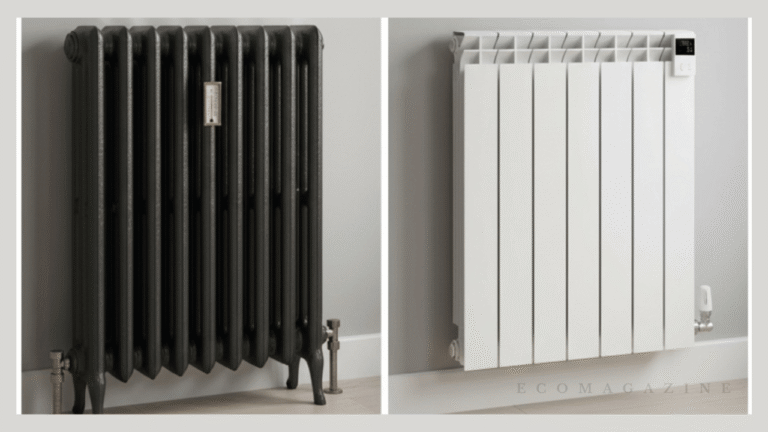Choosing between cast iron and steel radiators affects your home’s heating efficiency, energy bills, and interior design. This guide compares both materials to help you make an informed decision.
At a Glance:
- Cast Iron = Superior heat retention + classic design
- Steel = Fast heating + modern efficiency
What Are Cast Iron Radiators?
How Cast Iron Radiators Work
Cast iron radiators feature heavy, robust construction with high thermal mass. They store heat and release it slowly over extended periods, continuing to warm your space even after the heating system turns off.
Benefits of Cast Iron Radiators
Exceptional Heat Retention Cast iron radiators maintain warmth for hours after your heating system shuts off, providing consistent comfort throughout your home.
Long-Lasting Durability: These radiators often last 25+ years with minimal maintenance, making them a sound long-term investment despite higher upfront costs.
Perfect for Period Properties: cast-iron radiators complement Victorian homes, rustic interiors, and traditional décor with authentic period-appropriate designs.
Compatible with Low-Flow Systems: Ideal for older heating setups that may not have the high water pressure required by modern radiators.
Drawbacks of Cast Iron Radiators
Slower Initial Heat-Up Time: Cast iron takes 30-60 minutes longer to reach full temperature compared to steel alternatives.
Heavy Weight Requires Professional Installation: Substantial weight demands robust wall mounting and professional installation, increasing upfront costs.
Higher Purchase Price: Cast iron radiators typically cost 30-50% more than comparable steel models initially.
What Are Steel Radiators?
How Steel Radiators Work
Steel radiators feature lightweight construction with lower thermal mass. They heat up rapidly and respond quickly to thermostat adjustments, making them ideal for modern heating systems.
Benefits of Steel Radiators
Fast Heating Response: Steel radiators reach full temperature in 10-15 minutes, providing immediate comfort when needed.
Energy-Efficient Performance: Quick response times enable precise temperature control, potentially reducing energy consumption by 15-20% with smart controls.
Easy Installation and Maintenance: Lightweight construction allows for DIY-friendly installation and easy repositioning if needed.
Modern Design Options: Available in vertical, horizontal, and designer configurations with various finishes including chrome, matte black, and custom colors.
Drawbacks of Steel Radiators
Faster Heat Loss: Steel radiators cool down within 15-20 minutes after the heating system stops, causing more temperature fluctuations.
Potential Corrosion in Humid Areas: Bathrooms and moisture-prone spaces may experience corrosion over time, though modern coatings help prevent this.
Less Heat Storage Capacity: Lower thermal mass means less residual warmth between heating cycles.
Cast Iron vs Steel Radiators: Direct Comparison
Heat Performance Comparison
| Factor | Cast Iron | Steel |
| Heat-up time | 30-60 minutes | 10-15 minutes |
| Heat retention | 2-4 hours | 15-30 minutes |
| Temperature consistency | Excellent | Moderate |
| Energy efficiency | Best for continuous heating | Best for intermittent heating |
Durability and Maintenance
| Factor | Cast Iron | Steel |
| Lifespan | 25+ years | 15-20 years |
| Corrosion resistance | Excellent | Good with coating |
| Maintenance needs | Minimal | Moderate |
| Warranty period | 10-25 years | 5-10 years |
Cost and Installation
| Factor | Cast Iron | Steel |
| Purchase price | £200-£800+ | £100-£400 |
| Installation cost | £150-£300 | £75-£150 |
| Weight | 50-100+ kg | 10-30 kg |
| Installation difficulty | Professional required | DIY-friendly |
Design and Aesthetics
| Factor | Cast Iron | Steel |
| Style | Traditional, ornate | Modern, minimalist |
| Color options | Limited (usually painted) | Extensive range |
| Configuration options | Mainly horizontal | Horizontal + vertical + designer |
| Best for | Period properties | Contemporary homes |
Which Radiator Type Should You Choose?
Choose Cast Iron Radiators If You:
- Own a Victorian, Edwardian, or period property
- Want consistent warmth throughout the day
- Prioritize long-term durability over upfront costs
- Have a low-flow or older heating system
- Prefer traditional, characterful designs
- Run your heating for extended periods daily
Choose Steel Radiators If You:
- Live in a modern or contemporary home
- Need fast heating response times
- Want energy-efficient, responsive heating
- Have limited wall space (vertical options available)
- Prefer easier DIY installation
- Use programmable or smart heating controls
- Have budget constraints
Alternative Radiator Options
Aluminum Radiators Combine fast heating (like steel) with better heat retention than steel. Mid-range price point.
Dual-Fuel Radiators Work with both central heating and electric elements. Ideal for off-season use.
Column Radiators are Available in both cast iron and steel. Offer enhanced heat distribution in various column depths.
Design Tips: Matching Radiators to Your Interior
Cast Iron Radiators in Traditional Spaces
- Victorian homes with original features
- Country cottages and rustic interiors
- Heritage properties with exposed radiators
- Traditional bathrooms with freestanding tubs
Steel Radiators in Modern Environments
- Minimalist apartments and lofts
- Contemporary open-plan living areas
- Compact bathrooms with vertical designs
- Modern home offices
Color and Finish Selection Guide
Classic White: Universal choice, suits any décor
Anthracite/Black: Bold statement in modern spaces
Chrome: Luxurious finish for bathrooms
Brushed Steel: Industrial or contemporary look
Custom Colors: Match specific color schemes
Ready to Upgrade Your Heating?
Whether you choose the timeless appeal of cast iron or the modern efficiency of steel, proper installation and regular maintenance ensure optimal performance for years to come.
Next Steps:
- Assess your current heating system compatibility
- Measure available wall space and heat output needs
- Set your budget, including installation costs
- Consult with a qualified heating engineer
- Browse radiator collections that match your style
Always hire certified professionals for radiator installation to ensure safety, efficiency, and warranty compliance.
Final Verdict: Best Radiator for Your Home
Both cast iron and steel radiators have distinct advantages:
Cast iron radiators are ideal for traditional homes where durability, heat retention, and authentic aesthetics matter most. They’re the smart choice for continuous heating and period properties.
Steel radiators excel in modern settings where fast response, energy efficiency, and contemporary design are priorities. They’re perfect for homes with smart heating controls and intermittent heating needs.
The right choice depends on your home’s style, heating system, budget, and lifestyle. Consider consulting a heating engineer for personalized recommendations based on your specific requirements.
FAQs
Do cast-iron radiators use more energy than steel?
Not necessarily. Cast iron radiators are more efficient for continuous heating, while steel radiators excel with intermittent, responsive heating schedules.
Can I replace cast-iron radiators with steel?
Yes, but check your heating system’s compatibility. Steel radiators may require different flow rates and pressure settings.
How long do cast-iron radiators last?
With proper maintenance, cast iron radiators can last 25-50+ years, often outliving the heating system itself.
Are steel radiators suitable for bathrooms?
Yes, but choose models with quality anti-corrosion coatings specifically designed for high-humidity environments.
Which radiator type adds more value to a home?
Period-appropriate cast iron radiators can add value to traditional properties, while efficient steel radiators appeal to modern home buyers.


